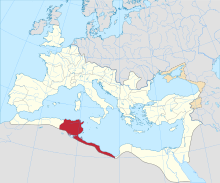Villamagna in Proconsulari was a town in the Roman province of Africa Proconsulare. It is identified with the modern village of Henchir Mettich, located around 50 km from Carthage in Tunisia.
Henchir-Tebel is a town and archaeological site in Al Qayrawān, Tunisia, near Kairouan

Aptuca (Africa) or Henchir Oudeka, also known as Aptucca/Aptuca, Henchir-Oudeka/Henchir-Semmech. or Udeka is a village and archaeological site in Tunisia, North Africa located at 36.409344, 8.940301.

Vallitanus or Vallis was an ancient Roman–Berber colonia in Carthage, Tunisia. The town is identified with ruins at Sidi Medien, where are located the remains of a Roman theatre, and a number of Roman inscriptions bearing witness to the town's name, and some local officials of the time can be found near the theatre.
Henchir-Belli, also known as Beled Belli, is a location and archaeological site in Tunisia.

Vegesela in Byzacena was a Roman Era town tentatively identified with ruins at Henchir-Recba in modern Tunisia. The town was in the Roman province of Byzacena.

Auzegera was a Roman-Berber town in the province of Africa Proconsularis and in late antiquity Byzacena. It was a Catholic Church diocese.
Drusiliana was a civitas (town) of Roman North Africa. Bingham called it a city of the Roman province of Mauretania Caesariensis. An inscription of Constantine the Great was found in the city ruins and it appears on the Tabula Peutingeriana The town has been tentatively identified with ruins near Khanguet-el-Kdim in northern Tunisia. Located at 36.249547°N 8.907667°E. Epigraphical evidence suggest Constantine the Great undertook some works in the city in 312AD.
Cincari was a Roman era civitas of Africa Proconsularae a town which has been tentatively identified with the ruins of Henchir Tengar in today's northern Tunisia. The ruins at Bordj Toum have also been proposed as an alternative for the town.

Tibiuca was a Roman era civitas of the Roman province of Africa Proconsularis.
Henchir-Boucha is a former Catholic diocese and archaeological site in Tunisia.
Henchir-Mâtria is an archaeological and prehistoric site in northern Tunisia. Henchir-Mâtria is at 36°31′23.4″N9°13′11.1″E, between Béja and Dougga and elevation of 407 metres. It is on the Oued el Beida River.
Henchir-Khachoum is a locality and series of archaeological sites in Sidi Bouzid Governorate modern Tunisia. The ruins are strewn along a tributary of the Oued El Hatech river east of Sbeitla. During the Roman Empire there was a Roman town of the Roman province of Africa Proconsularis, called Muzuca, one of two North African towns to bare that name.

Migirpa was an ancient Roman-Berber civitas in the province of Africa Proconsularis. It flourished from 30 BCE to 640 CE. The town is identified as stone ruins near Carthage, Tunisia.

The Diocese of Dices, is a titular see of the Roman Catholic Church. The location of the seat of the diocese is unknown for certain, but is perhaps identifiable with Henchir-Sidi-Salah, Tunisia. Henchir Sidi Salah was an ancient diocese in the Roman-Berber province of Byzacena.

Tabalta was an ancient Roman-Berber city in the province of Africa Proconsularis and of Byzacena during the late antiquity. It was a Catholic diocese led by Juan Bustos.

Forontoniana was a Roman town of the Roman province of Byzacena during late antiquity. The town has tentatively been identified with the ruins at Henchir-Bir-El-Menadla in modern Tunisia.

Garriana was a Roman town of the province of Byzacena during late antiquity. The town has tentatively been identified with the ruins at Henchir-El-Garra in modern Tunisia. The name Henchir-El-Garra simply means the Ruins of Garria.

Muzuca was a Roman Town of the Roman province of Byzacena during late antiquity. The town has tentatively been identified with the ruins at Henchir-Besra in modern Tunisia. Very little is known of the city, though in situ epigraphical evidence gives us the name and that in late antiquity it achieved the status of Municipium.

Marazanae was a Roman town of the Roman province of Byzacena during the Roman Empire and into late antiquity.




